Archive for the ‘Nail Fungus Cure’ Category
Curing Toenail Fungus with Prescription Drugs
Curing Toenail Fungus with Prescription Drugs
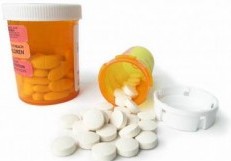 Thanks to the advancements of modern medicine, curing toenail fungus with antifungal prescription medicines has become quite regular. As this is an infection that can spread easily, both throughout a person’s nails and through a populous, treating it has become of higher concern than it used to be.
Thanks to the advancements of modern medicine, curing toenail fungus with antifungal prescription medicines has become quite regular. As this is an infection that can spread easily, both throughout a person’s nails and through a populous, treating it has become of higher concern than it used to be.
What does an infected toenail look like?
The first and most common symptom to develop is a whitish or yellowish spot on your nail. Gradually this will cover your entire nail and you may eventually develop dark yellow and brown spots on the nail. Your nail will become thick and brittle as the fungus burrows deep into and underneath the nail on its quest to spread.
Infection occurs when people are exposed to the spores of the fungus. This can happen if you wander around barefoot, especially in areas that are particularly dirty, if your shoes are dirty or excessively damaged, and if you have particularly sweaty feet as heat and humidity are two key ingredients to a successful fungus growing environment.
Nails can become discolored due to trauma at the nail site, rubbing of the nail from the shoe and even if you have psoriasis. It is best to consult your doctor to determine what is causing the discoloration so that you can work together to come up with the best treatment.
Your doctor will take a sample of your nail and examine it under a microscope as well as have it sent to a lab for culture. The point of this exercise is to determine if it is a fungal or bacterial infection, and if it is a fungal infection, which type of fungus is it? The more you know, the more effective your treatment will be.
Topical Medications
A standard topical medication prescribed for toenail fungus infections is Ciclipirox, commercially known as Penlac. This comes as a nail polish, which needs to be applied daily to the infected nail to destroy the fungal infection. This can take several months to occur, so be patient.
Side Effects
Penlac has been known to cause skin irritation and itching where it has been applied.
Oral Antifungal Medications
Common prescriptives for eradicating toenail fungus infections are Lamisil, known as Terbinafine, Sporanox and Itraconazole. All of these drugs will run at least a twelve week course and it takes about nine months for the nail to grow out to fully replace itself.
All of these drugs come with the risk of side effects. If you suffer severe abdominal pain, headaches, dizziness or nausea, vomiting or jaundice in the skin or eyes or if your urine becomes particularly dark, you need to cease taking the medication and report this to your doctor right away.
None of these prescriptions are recommended for people with liver or heart disorders.
Thanks to the advancements of modern medicine, curing toenail fungus with antifungal prescription medicines has become quite regular. As this is an infection that can spread easily, both throughout a person’s nails and through a populous, treating it has become of higher concern than it used to be.
Prescription Treatments for Onychomycosis – A Doctor’s Recommendations
Prescription Treatments for Onychomycosis
A Doctor’s Recommendations
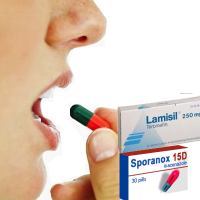 Where once onychomycosis was considered solely a cosmetic problem, doctors are treating it with greater concern. Nail fungus is unattractive, yes, but it also affects the infected person’s willingness to interact with others, especially in situations where exposing the infected nail or having other people come into contact with it may make the sufferer uncomfortable.
Where once onychomycosis was considered solely a cosmetic problem, doctors are treating it with greater concern. Nail fungus is unattractive, yes, but it also affects the infected person’s willingness to interact with others, especially in situations where exposing the infected nail or having other people come into contact with it may make the sufferer uncomfortable.
Beyond the psychological and social repercussions associated with onychomycosis, the basic function of the nail is disrupted. The point of having the nail sheath (the hard part of the nail) is to act as an armor for the soft tissue beneath and to assist in how we sense and interpret the world. A foot that has an infected nail or nails may interfere with normal sensation and even the ability to walk. Add to this the possibility of a nail fungal infection allowing for what is referred to as a ‘superinfection’, the chance that other bacteria and viruses could layer themselves on top of the fungal infection and cause further harm, and it is time to fix the problem.
These are the reasons behind the medical communities more aggressive treatment of onychomycosis. On the patient side of the equation, more people are requesting treatment and mentioning the problem to their doctors earlier to nip it in the bud.
There are two basic categories of treatment for onychomycosis. Oral (by mouth) and topical (applied directly to the infected area) Which treatment your doctor chooses will depend on a variety of factors. If the lunula (white area at the base of your fingernail) is affected by either distal subungual onychomycosis or proximal subungual onychomycosis then the oral medical prescription is the method of eradication. How the patient feels about the entire process is taken into account as well. Therefore it is not uncommon to use both an oral and a topical medication in conjunction. Working the infection from both sides of the body (in and out) can be a very effective treatment.
Choosing the oral prescription medication treatment is not to be considered lightly. One of the main drawbacks of this method of fungus eradication is that all of the antimycotic (antifungal) medications available for the treatment of onychomycosis have the potential to cause liver damage. It is imperative that your doctor test your liver function before beginning a course of these drugs and it is likely that your doctor will continue to monitor your liver during the treatment. If a patient has any history of or current liver problems, an oral medication should not be taken. The patient should monitor themselves as well, telling their doctor if they experience upper abdominal pain, malaise, fatigue, or if they notice jaundice (yellowing skin or yellowing of the eyes), pale colored stools or particularly dark urine.
In the past, Griseofulvin was the only available oral prescription medication to treat onychomycosis. It did work, but not terribly well and usually came with a passel of side effects, particularly when moderate to high doses were recommended. Griseofulvin treatment also took a long time and it was common for the infection to reoccur after the treatment stopped. Fortunately a variety of options have been created since then.
Terbinafine, more commonly known as Lamisil is very effective at fighting onychomycosis caused by dermatophytes, which is the most common cause of the disease. Terbinafine is prescribed as a 250 mg pill taken once a day for six weeks for fingernail infections and for twelve weeks if treating toenails. In some cases, pulse therapy (taking a drug for a certain period of time, then giving the body time off) has been effective. A complete blood count and liver panel should be taken before this treatment is started as well as four weeks into the therapy.
Itroconazole also known as Sporanox is also commonly administered in pulse dosing. The usual treatment schedule is 200 mg by mouth once a day for one week per month over the course of three months. Itraconazole can have negative reactions with several other forms of medication so telling your doctor exactly what you are currently taking before starting treatment is a medical necessity. A liver panel should be taken before this treatment is started and four weeks into the therapy.
Fluconazole, otherwise known as Diflucan is taken once a week in either 150 or 300 mg doses until the symptoms are gone. The treatment may last up to nine months before positive results are seen. Again, this drug may have negative interactions with other medications so tell your doctor what you are currently taking to avoid this. No blood tests are required when taking fluconazole but your doctor may order them anyway.
It is most common to use topical onychomycosis prescriptions in cases that are caught early on and therefore still mild, and in conjunction with an oral medical prescription. An incredibly effective topical prescription is Ciclopirox, commercially known as Penlac. This is an 8% topical solution that is applied to the infected area once a day. While it is a safer delivery method than oral antimycotics, when used alone it only achieved a 5% success rate.
When all other methods have failed, and/or in severe cases of onychomycosis, surgery becomes an options. There are three different methods of surgical nail removal: mechanical, chemical or surgical nail avulsion (removal). The nail can be mechanically or surgically avulsed (torn off) which is done after numbing the area with a local anesthetic as it can be quite painful. This is most common when the nail has already pulled away from the nail bed. A concentrated solution of 50% urea can be used to both eradicate the infection and soften the nail for removal and can be a fairly painless process. Once the nail has been removed, keeping the area clean and dry to prevent further or re-infection is necessary.
References
Ciclopirox (Penlac) prescribing information
Fluconazole (Diflucan) prescribing information
Itraconazole (Sporanox) prescribing information
Terbinafine (Lamisil) prescribing information
The Beer Soak Method – A Homeopathic remedy for nail fungus. How to do it and why it works.
The Beer Soak Method – A Homeopathic remedy
for nail fungus. How to do it and why it works.
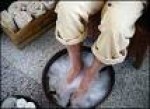 The strange yellow color that you see on your finger and toenails is not only unattractive but possibly harmful. This is caused by a fungus that lives just along the nail bed and beneath the nail itself. It is not uncommon for affected nails to become rough and thick, along with the yellowing that has already been spoken of. So if you don’t wish to take a prescription medication as recommended by a doctor, what do you do? Fortunately there is another option for folks who prefer the homeopathic approach to medicine.
The strange yellow color that you see on your finger and toenails is not only unattractive but possibly harmful. This is caused by a fungus that lives just along the nail bed and beneath the nail itself. It is not uncommon for affected nails to become rough and thick, along with the yellowing that has already been spoken of. So if you don’t wish to take a prescription medication as recommended by a doctor, what do you do? Fortunately there is another option for folks who prefer the homeopathic approach to medicine.
By combining dark beer, more commonly known as Stout, white vinegar, and acidophilus, a medicinal soak can be created to immerse the affected nails in. Acidophilus, a helpful bacteria, combined with the alcohol in the beer, work together to create an environment that is not conducive to the continued growth of the nail fungus.
So what is it about this mixture that makes it work to cure nail fungus problems?
By combining the vinegar and acidophilus, you are creating a negative climate for the nail fungus. High acidity environments kill off unproductive bacteria like fungus, while still allowing productive bacteria, like acidophilus to thrive and encourage their pro-biotic tendencies to help fight off infection. The alcohol in the beer works to soften the tissue around the nail as well as the nail itself, thus allowing the acidic environment to permeate (enter) the nail in order to do its job.
Nail Fungus Soak Recipe
Ingredients
- 1 tub or bowl large enough to soak the affected area (your feet or hands)
- 4 cups white vinegar
- 2 pints of Stout – Many beer companies make a stout or dark beer. Guinness is the most well known.
- 1 sachet of acidophilus – the standard sachet potency is 125 billion organisms.
- Nail File* Use once a week
Directions
Please note: Once you have made this mixture, the same batch can be used repeatedly for up to 48 hours. Don’t throw it out right away.
Mix the vinegar, stout and acidophilus in the soaking tub.
Soak the affected area (infected nails on your hands or feet) for 30 minutes.
After you have soaked the affected area for 30 minutes, remove your hands or feet from the mixture and wash the affected area with warm water and soap. Pat dry.
Repeat these directions twice a day for between 3 to 6 months, until the affected area clears up.
*Once a week: Immediately after removing your hands or feet from the mixture, (before washing with warm water and soap) Use a nail file to file the affected nails down, to expose new nail. Return the affected area to the mixture for an additional 30 minutes so that the newly exposed nail is able to receive the medicinal properties of the mixture, inhibiting the further growth of the fungus.
Some users may find that the area around their nails is sensitive to the soaking mixture. If this is the case, then reduce the frequency of treatment from twice a day to once a day.
This treatment should start to show efficacy within one week to one month, depending on the individual and the severity of the fungal infection. The treatment is most effective if strictly adhered to instead of missing regular treatments. Once the fungus starts to clear up, the nail in the affected areas will start to grow back strong and clear. As you trim your nails, cutting away the infected nail as you cure it, your nails will grow in healthy behind the damaged area. There should be no more yellowing or thickness in the healthy nail.
It takes about 12 weeks for the nail to grow in fully and replace itself from infected to unaffected area.
Home Remedies to Cure Nail Fungus
Home Remedies to Cure Nail Fungus
Is there any evidence that they work?
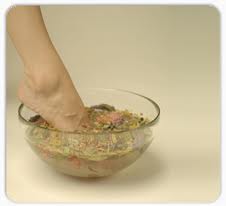 Many people suffer from onychomycosis, more commonly known as nail fungus or toenail fungus. Prescription drugs are available to cure this condition but many of them have been found to have side effects, such as Liver Damage, that can be severe. Because of this factor, people who have this condition search out alternative remedies to treat their onychomycosis. This begs the question, “Do these home remedies work? And if so, are they safe and which ones are the most effective?”
Many people suffer from onychomycosis, more commonly known as nail fungus or toenail fungus. Prescription drugs are available to cure this condition but many of them have been found to have side effects, such as Liver Damage, that can be severe. Because of this factor, people who have this condition search out alternative remedies to treat their onychomycosis. This begs the question, “Do these home remedies work? And if so, are they safe and which ones are the most effective?”
Several different home remedies have been suggested over the years for onychomycosis and other nail fungus treatment. Clinical trials have not been run on any of these home remedies; however there is anecdotal evidence that many of them do work. Sometimes it depends on the individual, or the kind of nail fungus they have, as to which remedies work and which don’t. Another factor is the ability of the remedy to get under the nail sheath and reach the infected area, which is usually underneath and in the nail bed itself. In favor of the home remedy, there is usually little to no risk of making anything worse than it already is, and these are usually inexpensive to try.
If the nail bed and lunula are affected, topical and over the counter medicines will not be effective, which also eliminates most home remedies. In these cases the only cure is an oral medication which requires a prescription from a doctor.
Remedy suggestion #1: Listerine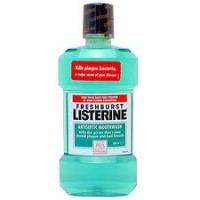
Listerine, a mouthwash that advertises the destruction of bacteria that cause gum disease is a very popular and inexpensive treatment for finger or toenail fungus. After all, if it destroys one kind of bacteria, why shouldn’t it be effective for getting rid of other kinds of bacteria? Ingredients in Listerine are ethanol, thymol, eucalyptol (from eucalyptus), and benzoic acid.
Standard treatment for onychomycosis using Listerine is to soak the affected area in Listerine for 10 minutes every night until the affected area clears.
Onychomycosis is caused by a few different factors. Infection from Candida is one of them, so if the Listerine can penetrate to the site of the infection, it is possible, even probable that this will be an effective treatment as Listerine has been shown to be effective against Candida. Another cause of onychomycosis is dermatophyte, which have not been demonstrated to be as negatively affected by Listerine’s chemical make-up. As the majority of onychomycosis are caused by dermatophyte, Listerine may not be effective in all cases of nail fungus as a home remedy.
Remedy suggestion #2: Vinegar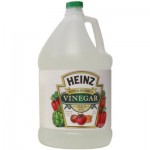
Vinegar, with its acidic environment helps to destroy the dermatophyte that cause onychomycosis. Also known as acetic acid, this remedy is made up of one part vinegar and two parts water. By soaking the affected area for 20 minutes per day, the acetic acid is able to create a less habitable climate for the fungus, thus discouraging its continued growth. Continue treatment until the affected area clears up. It is also possible that the skin around your nail will become irritated. If this is the case, treatment should be discontinued.
There has been no significant difference discovered in using apple cider vinegar vs. white vinegar nor over-the-counter remedies that contain acetic acid (vinegar) vs. using the vinegar and water mixture described above.
Remedy Suggestion #3: Vicks VapoRub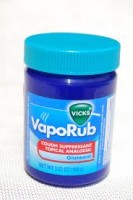
Because of the inherent make up of Vicks VapoRub, it does a better job of penetrating the nail to get to the source of the infection. This is a commonly recommended home remedy from physicians as they have seen improvements in patients who use this product. The petroleum jelly based mixture, infused with oils, such as menthol, allow for better infusion of the infected area.
Topical application is the only appropriate way to use Vicks VapoRub (after all, would you want to eat that stuff?) The “dose” is up to the applicant. The most common method of cure is to apply the substance to the affected nails and wear a sock or glove over the treatment. To prevent a re-occurrence of infection somewhere else, as fungus loves a moist environment, make certain to use a sock or glove that is 100% cotton for breath-ability.
Remedy suggestion #4: Tea Tree Oil
Tea Tree Oil, or Melaleuca Alternifolia has been found to be an effective natural anti-fungal. When applied in vitro (meaning poured into a dish, thus soaking like many of the other listed methods) Tea Tree Oil was found to discourage fungus growth in all of the common causes of onychomycosis, including Trichophyton mentagrophytes, Trichophyton rubrum, and Candida infections. Tea Tree Oil has been used in clinical trials and one of them reported a 20% cure rate while the other reported a 0% cure rate. The determining factor seems to be using 100% Tea Tree Oil instead of a diluted solution. The appearance of the nail fungus seemed to improve in people who used the 100% solution. Tea Tree Oil is recommended as a topical solution for many skin fungus conditions and has been seen to be effective in treating tinea pedis, a minor foot fungus. This is probably because the Tea Tree Oil is able to penetrate the infected area, thus reaching and eradicating the fungus.
Remedy Suggestion #5: Green Tea Extract
Camellia Sinensis or Green Tea Extract is another herbal remedy that has shown antifungal properties. When applied in vitro (in a dish) Green Tea Extract proved able to kill Candida glabrata. No one has done clinical trials with this herbal remedy so its effect on dermatophyte, and therefore onychomycosis is currently unknown.
Topical Medications to Treat Nail Fungus
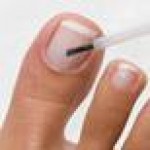 Topical Medications to Treat Nail Fungus
Topical Medications to Treat Nail Fungus
There are a wide variety of treatments available to cure nail fungus. Some of these treatments are oral and some are topical. Topical treatments are available as prescription, over-the-counter and natural or alternative. Most people prefer using a topical treatment to an oral medication because the topical medication has far fewer risks associated with its use.
The topical prescription medication Penlac (otherwise known as Ciclopirox) is a relative newcomer to the U.S. market. Approved by the FDA in 1999 and in Canada in 2004, this was a wonderful improvement in the treatment of nail fungus as up until then, prescription treatments were all systemic, the regimens were long, and ran the risk of damaging the internal organs.
Penlac delivers its antifungal medication in nail polish form. The main ingredient in Penlac is Ciclopirox, a broad spectrum antifungal. This medication works via its delivery method. Because the medication is painted directly onto the affected area, it has time to penetrate the nail and deliver the necessary antifungal boost to the nail bed, which is where the fungus grows. The concept of Penlac is to kill the fungus where it lives, underneath the nail, so that the infection is permanently eliminated. This avoids the necessity of taking oral antifungal medications, which work systemically (throughout the body) and have more side effects, including possible organ damage. Application of Penlac is suggested daily to the infected nail and surrounding tissue for up to 12 weeks.
In today’s modern world, you can choose from allopathic, or prescription remedies, and natural, or homeopathic remedies. The natural remedies are frequently available at your pharmacy or online. Many products are available to cure nail fungus but one of the most effective is ClearFungus. ClearFungus is available on line and comes with a money back guarantee. The website has many testimonials available for you to read. ClearFungus is a natural fungicide and its main ingredient, combined with other natural products, work together to promote healthy recovery for your skin and nails.
The natural health market has several topical products and they usually include the same basic ingredients. The difference ends up being in the price. When looking for a natural remedy, make sure you have access to the list of ingredients, whether on the product packaging or on a website. A natural remedy should include an active fungicide and preferably ingredients that encourage healthy nail re-growth and conditioning for the surrounding skin. An excellent option for a topical nail fungicide is Tea Tree Oil, which can be purchased at any health food store and many pharmacies. If you have the option, research has shown that a spray, lacquer, or heavy ointment, are all more effective than a cream.
How you choose to treat your nail fungus infection is something that you and your doctor need to decide. If you choose to go with a non-prescription product, make sure that you do your research so that you find a product that will work best for you. Remember that natural medicine is strong and can fix many problems (as it has been doing for centuries) but that prescriptive medicine is a derivative of natural medicine as many prescription cures come from a similar chemical make-up. There are times when a prescription medicine may be necessary, especially in the case of a severe infection. However you choose to treat your nail fungus, research all possible medication interactions and side effects and keep track of anything that may occur. Because no one understands your body better than you.